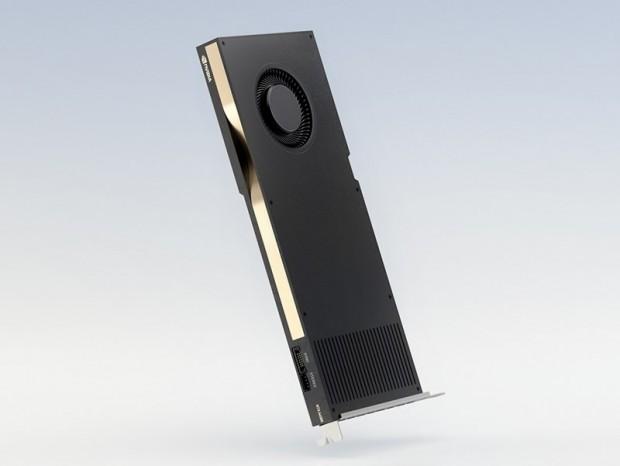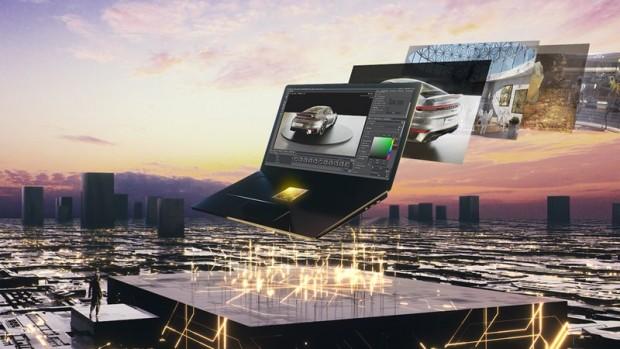NVIDIA held the annual conference "GTC21" online and announced the latest GPU for professional workstations at the keynote speech. Both have built-in 2nd generation RT cores and 3rd generation Tensor cores.
For desktops, the new "NVIDIA RTX A5000" and "NVIDIA RTX A4000" will be introduced. Following the flagship "NVIDIA RTX A6000" , the "NVIDIA RTX A5000" has 8,192 CUDA cores and 64 Tensor cores. It is equipped with GDDR6 24GB (384bit) video memory with ECC, and can use up to 48GB memory with NVLink connection. It also supports NVIDIA RTX vWS software for multiple high performance virtual workstations. The auxiliary power supply has an 8pin + 6pin configuration, and the TDP is 230W.
"NVIDIA RTX A4000" has 6,144 CUDA cores and 48 Tensor cores, and is equipped with GDDR6 16GB (256bit) video memory. Auxiliary power supply is 8pin x 1 and TDP is 140W. The connection interface is PCI-Express4.0 (x16), and the output interface is DisplayPort 1.4 x 4. The "NVIDIA RTX A5000" occupies two slots, and the "NVIDIA RTX A4000" uses a single-slot air-cooling fan for active cooling. Shipment is scheduled to begin later this month.
For notebook PCs, a new lineup of "NVIDIA RTX A5000", "NVIDIA RTX A4000", "NVIDIA RTX A3000" and "NVIDIA RTX A2000" has been added. Supports 3rd generation Max-Q technology with features such as "Dynamic Boost 2.0", "Whisper Mode 2.0" and "Resizable BAR". It implements up to 16GB of video memory for more advanced multi-application workflows.
Professional GPUs for new notebook PCs installed in mobile workstations will be available in the second quarter of 2021. For notebook PCs, new GPUs "NVIDIA T600" and "NVIDIA T1200" that adopted the previous generation Turing architecture will also be introduced.
"NVIDIA A16" and "NVIDIA A10" will be newly introduced as GPUs for data centers. The "NVIDIA A16" has a lower total cost of ownership (TCO) than the previous generation, and together with the "NVIDIA A10" has achieved up to 2.5 times the virtual workstation performance. Shipments are expected to begin later this month.
-- NVIDIA --
Using the new NVIDIA RTX™ GPUs, artists can create dazzling 3D scenes, designers can iterate on stunning building architecture in real time, and engineers can create groundbreaking products on any system.
“Hybrid work is the new normal,” said Bob Pette, vice president of Professional Visualization at NVIDIA. “RTX GPUs, based on the NVIDIA Ampere architecture, provide the performance for demanding workloads from any device so people can be productive from wherever they need to work.”
For desktops, the new NVIDIA RTX A5000 and NVIDIA RTX A4000 GPUs feature new RT Cores, Tensor Cores and CUDA® cores to speed AI, graphics and real-time rendering up to 2x faster than previous generations.
For professionals on the go needing thin and light devices, the new NVIDIA RTX A2000, NVIDIA RTX A3000, RTX A4000 and RTX A5000 laptop GPUs deliver accelerated performance without compromising mobility. They include the latest generations of Max-Q and RTX technologies and are backed by the NVIDIA Studio™ ecosystem, which includes exclusive driver technology that enhances creative apps for optimal levels of performance and reliability.
For the data center, there are the new NVIDIA A10 GPU and A16 GPU. The A10 provides up to 2.5x the virtual workstation performance of the previous generation for designers and engineers, while the A16 GPU provides up to 2x user density with lower total cost of ownership and an enhanced virtual desktop infrastructure experience over the previous generation.
Combined with NVIDIA RTX Virtual Workstation (vWS) and NVIDIA Virtual PC (vPC) software, the A10 and A16 GPUs deliver more power, memory and speed to boost any workflow, from graphics and AI to VDI, so users can focus more time on working efficiently and productively.
Customer Adoption
Among the first to tap into the RTX A5000 is Woods Bagot, a global architectural and consulting practice.
“This new NVIDIA Ampere GPU microarchitecture is a huge leap forward. I was shocked by the performance gain I saw with the NVIDIA RTX A5000 versus the equivalent model previous generation RTX when running applications such as Chaos Vantage and NVIDIA Omniverse,” said Robert Cervellione, studio leader of Design Technology at Woods Bagot. “It’s clear the NVIDIA RTX A5000 professional GPU was designed for this intensive multi-tasking compared to game-level cards.”
Polaris, a manufacturer of motorcycles, snowmobiles, ATV and electric vehicles, is also using the RTX A5000.
“Speed is everything when we need to evaluate new concepts for the most adventurous vehicles, and the NVIDIA RTX A5000 really delivers what we need,” said Erick Green, 3D/CGI lead at Polaris. “The basic viewport rendering is incredibly fast in Octane Render — 5x faster — and unlocks things we couldn’t have even tried before.”
“At Important Looking Pirates, we’re constantly pushing creative boundaries, and breakthrough technology is the great enabler,” said Ola Björling, producer of Virtual Production & Real-Time Graphics at Important Looking Pirates. “With the RTX A5000 powering NVIDIA Omniverse, we’re seeing high-end cinematic results in real time that used to take hours per frame.”
Next-Generation RTX Technology
The new NVIDIA RTX GPUs feature the latest generation of NVIDIA RTX technology to accelerate graphics, ray tracing, AI and compute. The new RTX laptop GPUs also include the latest generation of NVIDIA Max-Q technology, enabling a new generation of powerful thin and light laptops designed for professionals. Additionally, RTX technology powers NVIDIA Omniverse — the only platform that delivers high-performance, physically accurate simulation for complex 3D worlds and true real-time ray- and path-traced rendering with ease.
All the NVIDIA RTX GPUs feature the latest technologies in the NVIDIA Ampere architecture:
- Second-Generation RT Cores: Up to 2x the throughput of the previous generation, with the ability to run concurrent ray tracing, shading and denoising tasks.
- Third-generation Tensor Cores: Up to 2x the throughput of the previous generation, up to 10x with sparsity, with support for new TF32 and BFloat16 data formats.
- CUDA Cores: Up to 2.5x the FP32 throughput of the previous generation for significant increases in graphics and compute workloads.
Desktop GPU features and technology include:
- Up to 24GB of GPU memory: Double the memory of the previous generation, the RTX A4000 with 16GB GDDR6 memory and the RTX A5000 with 24GB of GDDR6 memory both support ECC memory for error-free computing. The RTX A5000 is expandable up to 48GB of memory using NVIDIA NVLink® to connect two GPUs.
- Virtualization: The RTX A5000 supports NVIDIA RTX vWS software for multiple high-performance virtual workstation instances that enable remote users to share resources to drive high-end design, AI and compute workloads.
- PCIe Gen 4: Doubles the bandwidth of the previous generation and speeds up data transfers for data-intensive tasks such as AI, data science and creating 3D models.
Laptop GPU features and technology include:
- Third-Gen Max-Q technology: For thin and light laptops that perform quieter and more efficiently with Dynamic Boost 2.0, WhisperMode 2.0, Resizable BAR and NVIDIA DLSS technology.
- Up to 16GB of GPU memory: For the largest models, scenes, assemblies and advanced multi-application workflows.
NVIDIA also introduced the NVIDIA T1200 and NVIDIA T600 laptop GPUs, based on its previous-generation Turing architecture. Designed for multi-application professional workflows, these GPUs are a significant upgrade in performance and capabilities from integrated graphics.
Availability
The new NVIDIA RTX desktop GPUs and NVIDIA data center GPUs will be available from global distribution partners and OEMs starting later this month.






